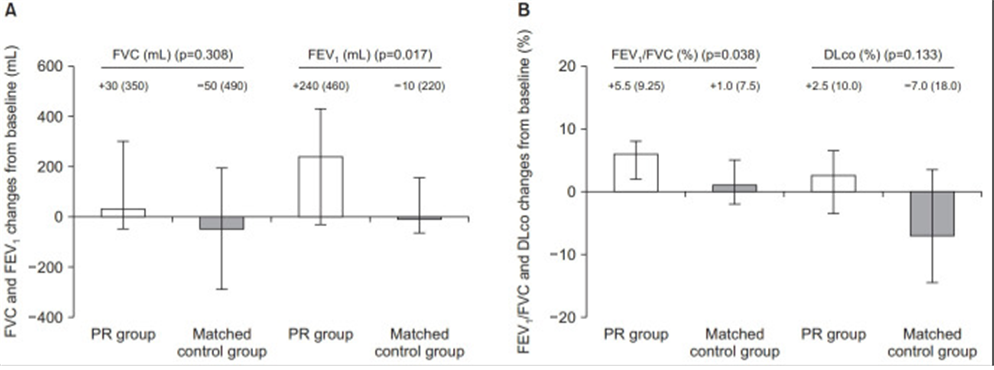글로벌 연구동향
방사선종양학
- [Tuberc Respir Dis (Seoul).] The Effects of Simultaneous Pulmonary Rehabilitation during Thoracic Radiotherapy in the Treatment of Malignant Diseases
울산의대 / 최명근, 이세원*
- 출처
- Tuberc Respir Dis (Seoul).
- 등재일
- 2021 Apr
- 저널이슈번호
- 84(2):148-158. doi: 10.4046/trd.2020.0135. Epub 2021 Feb 10.
- 내용
Abstract
Background: Radiotherapy is a common treatment option for lung or esophageal cancer, particularly when surgery is not feasible for patients with poor lung function. However, radiotherapy can affect pulmonary function and thereby induce pneumonitis or pneumonia, which can be fatal in patients with respiratory impairment. The purpose of this study is to evaluate if reductions in pulmonary function after radiotherapy can be minimized through simultaneous pulmonary rehabilitation (PR).Methods: In this matched case control study, we retrospectively analyzed patients who had undergone radiotherapy for thoracic malignant disease between January 2018 and June 2019. We analyzed results from pulmonary function tests and 6-minute walking tests (6MWT) conducted within the six months before and after radiotherapy treatment.
Results: In total, results from 144 patients were analyzed, with 11 of the patients receiving PR and radiotherapy simultaneously. Of the 133 patients in the control group, 33 were matched with 11 patients in the PR group. Changes in forced expiratory volume in one second (FEV1) and FEV1/forced vital capacity were significantly different between the PR group and the matched control group (240 mL vs. -10 mL, p=0.017 and 5.5% vs. 1.0%, p=0.038, respectively). The median distance of 6MWT in the PR group also increased significantly, from 407.5 m to 493.0 m after radiotherapy (p=0.017).
Conclusion: Simultaneous PR improved pulmonary function, particularly in measures of FEV1, and exercise capacity for patients with lung or esophageal cancer even after radiotherapy treatment. These findings may provide an important base of knowledge for further large population studies with long-term follow-up analysis in the identification of the PR's effects during thoracic radiotherapy.

Affiliations
Myeong Geun Choi 1 , Hyang Yi Lee 1 , Si Yeol Song 2 , Su Ssan Kim 2 , Seung Hak Lee 3 , Won Kim 3 , Chang-Min Choi 1 4 , Sei Won Lee 1
1 Department of Pulmonary and Critical Care Medicine, Asan Medical Center, University of Ulsan College of Medicine, Seoul, Republic of Korea.
2 Department of Radiation Oncology, Asan Medical Center, University of Ulsan College of Medicine, Seoul, Republic of Korea.
3 Department of Rehabilitation Medicine, Asan Medical Center, University of Ulsan College of Medicine, Seoul, Republic of Korea.
4 Department of Oncology, Asan Medical Center, University of Ulsan College of Medicine, Seoul, Republic of Korea.
- 키워드
- Pulmonary Function Tests; Pulmonary Rehabilitation; Radiotherapy.
- 연구소개
- 폐암을 포함한 흉부 암에서 방사선치료는 폐기능이 안 좋거나 전신 상태가 좋지 않아 수술적 치료가 어려운 경우에 택하게 되는 경우가 많음 이런 환자들이 방사선 치료를 받을 경우 치료 중 폐기능 및 전신 상태가 악화되는 것을 최소화하기 위해 방사선 치료와 동시에 호흡재활을 시행. 그 결과 주1회 이상 규칙적으로 호흡재활을 동시에 수행한 경우 운동능력 (6분보행검사) 및 폐기능에서 통계적으로 유의한 개선을 보임.
- 덧글달기










편집위원
적은 환자수를 대상으로 하였지만 폐부위에 방사선치료를 받는 중 폐재활훈련을 진행할 때 폐기능이 향상된다는 흥미로운 연구결과로 방사선치료 시 폐기능 악화가 염려되는 경우 참고할만한 논문입니다.
2021-06-04 17:50:57